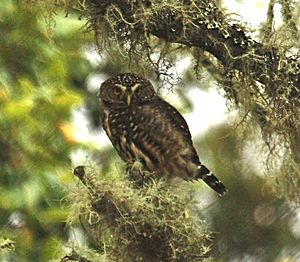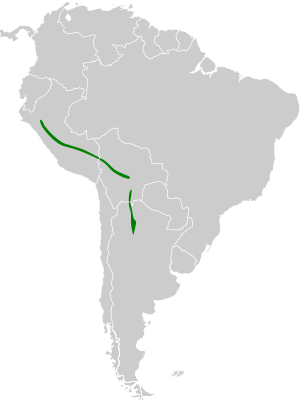Yungas pygmy owl facts for kids
Quick facts for kids Yungas pygmy owl |
|
|---|---|
 |
|
| On the road from Cuzco to Cock-of-the-Rock Lodge - Peru | |
| Conservation status | |
| Scientific classification | |
| Genus: |
Glaucidium
|
| Species: |
bolivianum
|
 |
|
| Distribution of Yungas pygmy owl Resident | |
The Yungas pygmy owl (Glaucidium bolivianum) is a small type of owl. It belongs to the owl family called Strigidae. This special owl lives in South America. You can find it in countries like Argentina, Bolivia, and Peru.
Contents
About the Yungas Pygmy Owl
The Yungas pygmy owl was once thought to be a type of Andean pygmy owl. But since the 1990s, scientists have agreed it is its own unique species. It is very similar to the Andean pygmy owl, like a close cousin. This owl is also "monotypic," which means it does not have any different subspecies.
What Does It Look Like?
The Yungas pygmy owl is about 16 cm (6.3 in) long. That's about the size of a small ruler! Male owls usually weigh between 55 to 58 g (1.9 to 2.0 oz). Female owls are a bit heavier, weighing about 66.5 g (2.35 oz) on average.
These owls can come in three different colors. There's a rare gray color, and then more common brown and reddish-brown (rufous) colors. All of them have light-colored dots on their head, back, and upper wings. They also have light bands on their tail. A cool feature is their "false eyes" on the back of their neck. These markings look like eyes and might help scare away predators. Their undersides are light with brownish stripes on their sides and belly.
Where Does It Live?
The Yungas pygmy owl lives on the eastern side of the Andes mountains. You can find them from Peru, south through Bolivia, and into northwestern Argentina. They usually live at high elevations, from about 1,400 and 3,000 m (4,600 and 9,800 ft) above sea level. Sometimes, they can be found as low as 900 m (3,000 ft). In Bolivia, they can even live as high as 3,900 m (12,800 ft).
These owls prefer to live in montane forests and cloudforests. These forests often have lots of thick plants, moss, and other plants growing on trees (called epiphytes). They also live in forests with Podocarpus trees. You'll usually spot them in the middle or upper parts of the forest, up in the tree branches.
How Does It Behave?
What Does It Eat?
The Yungas pygmy owl mostly hunts at night (it's nocturnal). It also hunts during dawn and dusk (this is called crepuscular activity). Sometimes, it might even be active during the day! It usually looks for food in the tree canopy and in the thick leaves below. Its diet includes insects and other arthropods (like spiders), small birds, and maybe even small reptiles.
Reproduction and Life Cycle
Scientists don't know much about how the Yungas pygmy owl reproduces. They think these owls probably make their nests in old holes that woodpeckers have made in trees.
What Does It Sound Like?
The song of the Yungas pygmy owl is a "rather slow series of equally spaced hollow notes." Sometimes, it starts its song with two or three whistled notes before the main series of sounds.
Conservation Status
The IUCN (International Union for Conservation of Nature) has looked at the Yungas pygmy owl. They have listed it as a species of Least Concern. This means it is not currently in danger of disappearing. However, its population size is not known for sure. Scientists believe its numbers might have gone down since it was first discovered.
The biggest threats to this owl are likely the destruction and damage of its forest home. But because some parts of its habitat are hard to reach, it has some natural protection.
See also
 In Spanish: Mochuelo boliviano para niños
In Spanish: Mochuelo boliviano para niños


